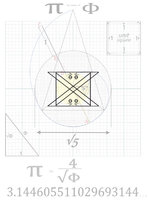You are using an out of date browser. It may not display this or other websites correctly.
You should upgrade or use an alternative browser.
You should upgrade or use an alternative browser.
Relating π to Φ
- Thread starter nothing
- Start date
- Status
- Not open for further replies.
D
Deleted member 4993
Guest
Can we simply ignore this babble and not respond?
- Joined
- Nov 24, 2012
- Messages
- 3,021
nothing
New member
- Joined
- Dec 9, 2019
- Messages
- 46
It seems you may have some axe to grind with the mathematics community, and/or are a crank. At any rate, I have stated why I dismissed your impossible claim.
A moderator name-calling? Really? Are you also into the identity politics of slandering people as "cranks" who don't agree with you?
Yes, both \(\pi\) and \(\phi\) are irrational, but \(\phi\) is an algebraic number while \(\pi\) is not; it is transcendental. The number:
[MATH]\frac{4}{\sqrt{\phi}}[/MATH]
is a root of:
[MATH]f(x)=x^4+16x^2-256[/MATH]
A transcendental number can never be a root of a non-zero polynomial in one variable with rational coefficients. This is one reason many here will likely dismiss your claim at a glance.
Is nonsense: because Φ is itself geometric, as long as it is coupled to π,
(which it is, by way of being the very base of it) that π is "transcendental" is irrelevant.
The geometric portion always holds: like imaginary numbers acting on real ones.
(π+π√5)/2π is a valid representation of Φ, and as Jeff pointed out:
A unit circle is a circle with radius 1 rather than a diameter of 1.
MY error was designating the circle corresponding to the unit square as a unit circle, when in fact it is not, rather r=2, so
thank you to Jeff for pointing that out - was the most helpful response. I take it no further contention despite orthodoxy.
Last edited:
Found this little tidbit. You'd think OP would have found it if they were at all serious about the topic.
https://johncarlosbaez.wordpress.com/2017/03/07/pi-and-the-golden-ratio/
https://johncarlosbaez.wordpress.com/2017/03/07/pi-and-the-golden-ratio/
nothing
New member
- Joined
- Dec 9, 2019
- Messages
- 46
Found this little tidbit. You'd think OP would have found it if they were at all serious about the topic.
https://johncarlosbaez.wordpress.com/2017/03/07/pi-and-the-golden-ratio/
Well how nice of you to have been researching the topic.
The problem is summarized:
"by approximating the circumference of a circle using a regular 96-gon... "
1. Using straight-line polys to approximate a curve is stupid, and
2. Archimedes was obviously unaware of the relationship between Φ and π, however I know he is an idol upon mathematicians.
I already found what I was looking for:

However please continue to worship the dead Archimedes and his poly "approximation".
How can humanity be this stupid, and for so long?
What Φ is to image/linear, π is to likeness/curvature.
In whose image and likeness are the skies and the terrains created?
As well as the Eve (π) who is derived from Adam's (Φ) own rib?
This whole thread is a quintessential example of beating a dead horse. Who cares?
Last edited by a moderator:
nothing
New member
- Joined
- Dec 9, 2019
- Messages
- 46
RomsekFound this little tidbit. You'd think OP would have found it if they were at all serious about the topic.
https://johncarlosbaez.wordpress.com/2017/03/07/pi-and-the-golden-ratio/
Thank you.
First, a demonstration of how to present a demonstration.
Second, a proof that the OP's specific conclusion was wrong, which as Mark pointed out, was known from general principles.
Third, something that should (but probably will not) please the OP: an exact relationship between pi and phi using an infinite process.
nothing
New member
- Joined
- Dec 9, 2019
- Messages
- 46
Romsek
Thank you.
First, a demonstration of how to present a demonstration.
Second, a proof that the OP's specific conclusion was wrong, which as Mark pointed out, was known from general principles.
Third, something that should (but probably will not) please the OP: an exact relationship between pi and phi using an infinite process.
The fundamental premise of the "proof" is false: you simply can't use straight-edged polys to find a curve to exactitude: you will always be short, infinite process or not. The surface of a sphere if/when represented on a 2D surface requires some "backwards" curvature apparatus to measure the circumference which can not even be represented visually, let alone "approximated" by a straight line. You can't "bend" a "straight" line such to capture the area under the curve: however, you can use a "bent" line which is scale-invarant, which is precisely what the golden spiral is.
However the four golden triangles fixes this problem due to the proportions cancelling out such to only be left with a function of √Φ
as Φ naturally produces the curve we need to measure the entire circumference.
You're missing an entire portion of the circle if you use lines. This can only be overcome by the association of the line-to-curve that the golden spiral and associated golden triangle provides. This is all the proof does: uses a curve to measure a curve. What is the problem?One of the moderators or an administrator , please lock/close this thread ASAP. You have seen what it has
devolved into.
Last edited by a moderator:
nothing
New member
- Joined
- Dec 9, 2019
- Messages
- 46
The last post (which had been #31) was reported. I requested the deletion of said post, the repeated request to lock this thread,
and the banning of user nothing. Thank you.

Here is a flower - will you calm down?
All I did was copy/paste the golden spiral, doubled it each time and bulged the interior such to reveal the internal symmetry.
Isn't it pretty?
Last edited by a moderator:
- Status
- Not open for further replies.

